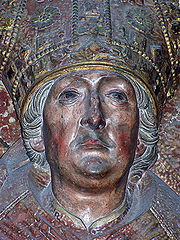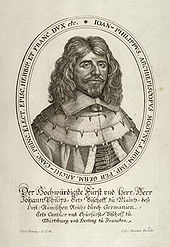
Bishopric of Würzburg
Encyclopedia
The Bishopric of Würzburg was a prince-bishop
ric in the Holy Roman Empire
, located in Lower Franconia
, around the city of Würzburg
, Germany
. Würzburg was a diocese from 743. In the 18th century, its bishop
was often also Bishop of Bamberg. The last few prince-bishops resided at the Würzburg Residence
, which is one of the grandest baroque
palaces in Europe.
As a consequence of the 1801 Treaty of Lunéville
, the Bishopric of Würzburg was secularized in 1803 and annexed by the Elector of Bavaria. In the same year Ferdinand III
, former Grand Duke of Tuscany
, was compensated with the Electorate of Salzburg
. In the 1805 Peace of Pressburg
, Ferdinand lost Salzburg to the Austrian Empire
, but was compensated with the new Grand Duchy of Würzburg
, Bavaria having relinquished the territory in return for the Tyrol
. This new state lasted until 1814, when it was once again annexed by Bavaria.
The Roman Catholic Diocese of Würzburg
was reestablished in 1821 without temporal power.
awarded the territory of Eastern Franconia (Ostfranken) to his nephew Conrad of Hohenstaufen
, who used the title "Duke of Franconia." Franconia remained a Hohenstaufen power base until 1168, when the Bishop of Würzburg was formally ceded the ducal rights in Eastern Franconia. The name "Franconia" fell out of usage, but the bishop revived it in his own favour in 1442 and held it until the reforms of Napoleon Bonaparte abolished it. The Bishop of Würzburg was more properly the Duke in Franconia (Herzog in Franken) rather than the Duke of Franconia (Herzog von Franken) during this time although both titles were used.
.
The charge of the original coat of arms showed the “Rennfähnlein” banner, quarterly argent and gules, on a lance or, in bend, on a blue shield.
In the 14th century another coat of arms was created. The coat of arms represents the holism of heaven and earth. The three white pikes represent the trinity of god and the four red pikes, directed to earth, stand for the four points of the compass, representing the whole spread of earth. The red colour represents the blood of Christ.
The Prince-Bishops used both within their personal coat of arms. The Rechen and the Rennfähnlein represented the diocese, while the other (usually two) fields showed the personal coat of arms of the bishop’s family. The coat of arms showed the Rechen in the first and third field, the Rennfähnlein in the second and fourth field.


 Secular power lost in 1803. Territory ceded to Bavaria until 1805.
Secular power lost in 1803. Territory ceded to Bavaria until 1805.
Prince-Bishop
A Prince-Bishop is a bishop who is a territorial Prince of the Church on account of one or more secular principalities, usually pre-existent titles of nobility held concurrently with their inherent clerical office...
ric in the Holy Roman Empire
Holy Roman Empire
The Holy Roman Empire was a realm that existed from 962 to 1806 in Central Europe.It was ruled by the Holy Roman Emperor. Its character changed during the Middle Ages and the Early Modern period, when the power of the emperor gradually weakened in favour of the princes...
, located in Lower Franconia
Lower Franconia
Lower Franconia is one of the three administrative regions of Franconia in Bavaria , Germany ....
, around the city of Würzburg
Würzburg
Würzburg is a city in the region of Franconia which lies in the northern tip of Bavaria, Germany. Located at the Main River, it is the capital of the Regierungsbezirk Lower Franconia. The regional dialect is Franconian....
, Germany
Germany
Germany , officially the Federal Republic of Germany , is a federal parliamentary republic in Europe. The country consists of 16 states while the capital and largest city is Berlin. Germany covers an area of 357,021 km2 and has a largely temperate seasonal climate...
. Würzburg was a diocese from 743. In the 18th century, its bishop
Bishop
A bishop is an ordained or consecrated member of the Christian clergy who is generally entrusted with a position of authority and oversight. Within the Catholic Church, Eastern Orthodox, Oriental Orthodox Churches, in the Assyrian Church of the East, in the Independent Catholic Churches, and in the...
was often also Bishop of Bamberg. The last few prince-bishops resided at the Würzburg Residence
Würzburg Residence
The Würzburg Residence is a palace in Würzburg, southern Germany. Johann Lukas von Hildebrandt and Maximilian von Welsch, representants of the Austrian/South German Baroque were involved in the construction, as well as Robert de Cotte and Germain Boffrand, who were followers of the French Style...
, which is one of the grandest baroque
Baroque
The Baroque is a period and the style that used exaggerated motion and clear, easily interpreted detail to produce drama, tension, exuberance, and grandeur in sculpture, painting, literature, dance, and music...
palaces in Europe.
As a consequence of the 1801 Treaty of Lunéville
Treaty of Lunéville
The Treaty of Lunéville was signed on 9 February 1801 between the French Republic and the Holy Roman Emperor Francis II, negotiating both on behalf of his own domains and of the Holy Roman Empire...
, the Bishopric of Würzburg was secularized in 1803 and annexed by the Elector of Bavaria. In the same year Ferdinand III
Ferdinand III, Grand Duke of Tuscany
Ferdinand III, Grand Duke of Tuscany was Grand Duke of Tuscany from 1790 to 1801 and, after a period of disenfranchisement, again from 1814 to 1824. He was also the Prince-elector and Grand Duke of Salzburg and Grand Duke of Würzburg .-Biography:Ferdinand was born in Florence, Tuscany, into the...
, former Grand Duke of Tuscany
Grand Duchy of Tuscany
The Grand Duchy of Tuscany was a central Italian monarchy that existed, with interruptions, from 1569 to 1859, replacing the Duchy of Florence. The grand duchy's capital was Florence...
, was compensated with the Electorate of Salzburg
Electorate of Salzburg
The Electorate of Salzburg , occasionally known as the Grand Duchy of Salzburg, was an electoral principality of the Holy Roman Empire from 1803–05. Its capital was Salzburg.- History :...
. In the 1805 Peace of Pressburg
Peace of Pressburg
The Peace of Pressburg refers to four peace treaties concluded in Pressburg . The fourth Peace of Pressburg of 1805 during the Napoleonic Wars is the best-known.-First:...
, Ferdinand lost Salzburg to the Austrian Empire
Austrian Empire
The Austrian Empire was a modern era successor empire, which was centered on what is today's Austria and which officially lasted from 1804 to 1867. It was followed by the Empire of Austria-Hungary, whose proclamation was a diplomatic move that elevated Hungary's status within the Austrian Empire...
, but was compensated with the new Grand Duchy of Würzburg
Grand Duchy of Würzburg
The Grand Duchy of Würzburg was a German grand duchy centered on Würzburg existing in the early 19th century.As a consequence of the 1801 Treaty of Lunéville, the Bishopric of Würzburg was secularized in 1803 and granted to Bavaria. In the same year Ferdinand III, former Grand Duke of Tuscany, was...
, Bavaria having relinquished the territory in return for the Tyrol
County of Tyrol
The County of Tyrol, Princely County from 1504, was a State of the Holy Roman Empire, from 1814 a province of the Austrian Empire and from 1867 a Cisleithanian crown land of Austria-Hungary...
. This new state lasted until 1814, when it was once again annexed by Bavaria.
The Roman Catholic Diocese of Würzburg
Roman Catholic Diocese of Würzburg
The Diocese of Würzburg is a diocese of Catholic Church in Germany. The diocese is located in Lower Franconia, around the city of Würzburg, and the bishop is seated at Würzburg Cathedral...
was reestablished in 1821 without temporal power.
Duke in Franconia
In 1115, Henry VHenry V, Holy Roman Emperor
Henry V was King of Germany and Holy Roman Emperor , the fourth and last ruler of the Salian dynasty. Henry's reign coincided with the final phase of the great Investiture Controversy, which had pitted pope against emperor...
awarded the territory of Eastern Franconia (Ostfranken) to his nephew Conrad of Hohenstaufen
Conrad III of Germany
Conrad III was the first King of Germany of the Hohenstaufen dynasty. He was the son of Frederick I, Duke of Swabia, and Agnes, a daughter of the Salian Emperor Henry IV.-Life and reign:...
, who used the title "Duke of Franconia." Franconia remained a Hohenstaufen power base until 1168, when the Bishop of Würzburg was formally ceded the ducal rights in Eastern Franconia. The name "Franconia" fell out of usage, but the bishop revived it in his own favour in 1442 and held it until the reforms of Napoleon Bonaparte abolished it. The Bishop of Würzburg was more properly the Duke in Franconia (Herzog in Franken) rather than the Duke of Franconia (Herzog von Franken) during this time although both titles were used.
Coat of arms
In 741 or 742 the first bishop of Würzburg was consecrated by Saint BonifaceSaint Boniface
Saint Boniface , the Apostle of the Germans, born Winfrid, Wynfrith, or Wynfryth in the kingdom of Wessex, probably at Crediton , was a missionary who propagated Christianity in the Frankish Empire during the 8th century. He is the patron saint of Germany and the first archbishop of Mainz...
.
The charge of the original coat of arms showed the “Rennfähnlein” banner, quarterly argent and gules, on a lance or, in bend, on a blue shield.
In the 14th century another coat of arms was created. The coat of arms represents the holism of heaven and earth. The three white pikes represent the trinity of god and the four red pikes, directed to earth, stand for the four points of the compass, representing the whole spread of earth. The red colour represents the blood of Christ.
The Prince-Bishops used both within their personal coat of arms. The Rechen and the Rennfähnlein represented the diocese, while the other (usually two) fields showed the personal coat of arms of the bishop’s family. The coat of arms showed the Rechen in the first and third field, the Rennfähnlein in the second and fourth field.
Bishops of Würzburg, 743–1808



See also
- Würzburg CathedralWürzburg CathedralWürzburg Cathedral is a Roman Catholic cathedral in Würzburg in Bavaria, Germany, dedicated to Saint Kilian. It is the seat of the Bishop of Würzburg...
for burial locations of most Würzburg bishops - Ebrach AbbeyEbrach AbbeyEbrach Abbey was a Cistercian monastery in Ebrach in Oberfranken, Bavaria, Germany. It is located in the Bishopric of Würzburg....
Beginning with the 13th century, the bishops of Würzburg had their heartsHeart-burialHeart-burial is a type of burial in which the heart is interred apart from the body. This is a very ancient practice, and the special reverence shown towards the heart is doubtless due to its early association with the soul, affections, courage and conscience of man.In medieval Europe heart-burial...
brought to the monastery in Ebrach (entrails to the chapel of the Marienburg, bodies to the St. Kilian cathedral). About 30 hearts of bishops, some of which had been desecrated during the German Peasants' WarGerman Peasants' WarThe German Peasants' War or Great Peasants' Revolt was a widespread popular revolt in the German-speaking areas of Central Europe, 1524–1526. At its height in the spring and summer of 1525, the conflict involved an estimated 300,000 peasants: contemporary estimates put the dead at 100,000...
, are said to have found their final resting place at Ebrach. The prince-bishop Julius Echter von MespelbrunnJulius Echter von MespelbrunnJulius Echter von Mespelbrunn was a Prince-Bishop of Würzburg, Echter was born in Mespelbrunn Castle, Spessart and died in Würzburg....
broke with this tradition and had his heart buried in the Neubaukirche.

